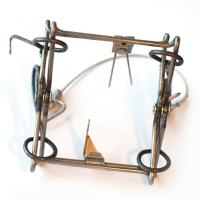
In the 1970s, the Federal Provincial Committee on Humane Trapping was formed, largely due to pressure from both The Fur-Bearer’s work as well as the international community. The goal, at the time, was to determine if traps could be made to be truly humane.
As you know from our history, The Fur-Bearers eventually determined that trapping could never be humane, at least by any reasonable definition of the term. But the government, who wanted to continue profiting from the deaths of wildlife, pushed forward.
The testing of so-called kill traps was one of many experiments performed at a facility funded by the government in Vegreville, Alberta.
This paper, found in the bowels of the Fur Institute of Canada’s website, explained that 35-types of traps were tested with 198 “AA” (anesthetised animals) and 333 “UA” (unanesthetised animals).
The anesthetised animal tests were described in the paper:
“For AA tests, staff anaesthetized animals with an intramuscular injection of 10 – 20 mg/kg of ketamine hydrochloride (Kreeger 1996). After the initial injection, staff injected additional drug or allowed time to elapse until animals were supine with strong palpebral and corneal reflexes in both eyes. Palpebral reflexes are blinking reflexes in responses to touching the eyelids and corneal reflexes are blinking responses to touching the cornea (Kreeger 1996). Staff then positioned animals in the traps to receive the same strike locations dictated by the approach tests. After traps were fired, staff continuously monitored the palpebral and corneal reflexes of test animals.
“Animals were considered irreversibly insensible once all palpebral and corneal reflexes were lost.
“If animals maintained eye reflexes at 300 seconds, staff euthanized them with an intra-cardiac injection of 200 mg/kg of sodium pentobarbital. Once the eye reflexes were irreversibly lost, staff monitored the heartbeat to cessation with a stethoscope.”
This is but one of the testing methods employed to determine how “humane” a trap was. We’ll continue sifting through research notes, papers and studies to find more highlights of activities at this disturbing research centre.
Work like our growing Make Fur History campaign is only possible with the support of monthly donors. Please consider become a monthly donor – for as little as $5 a month – and help us create a Canada that is truly fur-free.

